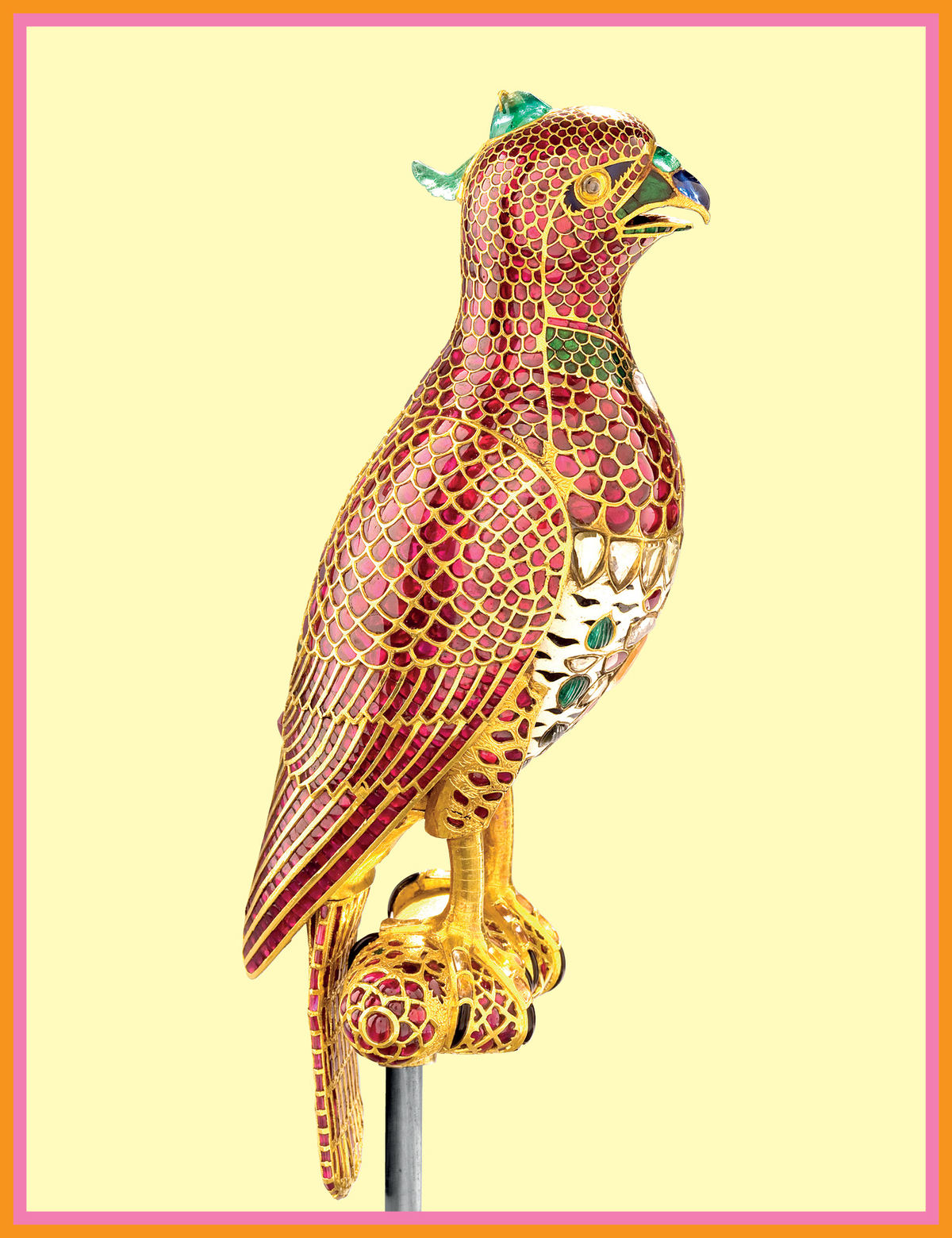Vidya Dehejia’s India: A Story Through 100 Objects might be called “mosaic history,” an assembly of discrete, outwardly disconnected pieces in service of an integrated whole. The material is beautiful and well chosen, its descriptions crisp and informative. But the “story,” like the mosaic, can only be judged when one draws back.
Her division is thematic and chronological: object one is an ancient (circa 500,000 B.C.E.) hand axe; object 100, the subcontinent’s everyday profusion of pink (punctuated, naturally, by Diana Vreeland—“Pink is the navy blue of India!”). The 20 chapters address India’s prehistory, legacy of exchange, and courtly and temple cultures; illustrated manuscripts, scientific “insights,” and brilliant jewels; carving and sculpture.
There are pleasures to be found on nearly every page. Objects two and three, an exquisite (one-inch-across) third-millennium B.C.E. humped bull seal and an anthropomorph (1,000 B.C.E.; likely “an object of veneration”), recall nothing so much as Picasso’s lithographic bull abstractions and Calder’s critters. On the subject of bulls, immense granite mounts from the 15th and 17th centuries C.E. (object 26) show their spiritual dimension.
It’s not difficult to understand India’s “universal compulsion” to adorn (alamkara) after inspecting the pair of granulated gold ear ornaments at the Metropolitan Museum of Art (object 10) or the gold, diamond, and emerald sarpech (turban ornament; object 12) like that worn by the Nizam of Hyderabad on the cover of Time in 1937. (He was billed as “the richest man in the world”; in 1938, Hitler was to be the magazine’s Man of the Year.)
A second-century C.E. stupa railing pillar (object 15), depicting “carvings of women who are clearly not Indian … play[ing] a set of largely non-Indian instruments,” represents the justly celebrated fusion of Greco-Roman and Buddhist traditions in Gandhara, on the modern border of Afghanistan and Pakistan. “It suggests,” Dehejia writes, “that northwest India between the fourth century B.C.E. and the fourth/fifth century C.E. had a multicultural mindset that was at ease with a range of belief systems and artistic ideals.”
Blended styles and sensibilities are, naturally, the rule rather than the exception. The enlightened Muslim Mughal emperor Akbar (who reigned from 1556 to 1605) commissioned Persian translations of Hindu Sanskrit texts—see the beguiling miniature of the yellow-robed Krishna dancing on Kaliya’s black, multi-headed serpentine form (object 29). A 14th-century statue of the elephant-headed Hindu deity Ganesha decorated with nine skulls, reflecting the tantric worship of both Shiva and the Buddha, was fashioned in Indonesia, today the world’s most populous Muslim country (object 40).
Objects two and three recall nothing so much as Picasso’s lithographic bull abstractions and Calder’s critters.
I have always particularly loved Dehejia’s 61st object, Abu’l Hasan’s wonderfully juxtaposed portraits of Akbar’s son, Jahangir, and the Jesuit-inspired Christ holding the cross. (Rembrandt would, meanwhile, copy Mughal drawings.)
During the North Indian Gupta dynasty (fourth century C.E.), coins were issued displaying the emperor Samudragupta in the various manifestations of ideal leadership (object 32).
Back then, courage and ability on their own wouldn’t do. The king ought to have “a well formed, smooth, and healthy body; this was to be accompanied by dignity of bearing, a graceful gait, and the adoption of elegant seated postures. A vital component was alamkara … with gold and gems that illuminated and enhanced beauty, a light that was also indicative of wisdom and strength. An important component was refinement of speech, and the ability to converse deftly and correctly as was appropriate to different situations. Accompanying all this was the art of love, seen as an elaborate game that cultured individuals should master while retaining total control of themselves.”
Mercifully, the Guptas aren’t around to recoil from our anti-Guptan political class.
Back then, courage and ability on their own wouldn’t do. The king ought to have “a well formed, smooth, and healthy body; this was to be accompanied by dignity of bearing, a graceful gait, and the adoption of elegant seated postures.”
“What is the meaning and intent,” Dehejia asks, “of [the] striking and unusual wooden painted object, all of six feet in length, that depicts a tiger in the act of mauling a British soldier?” She refers, of course, to Tipu Sultan’s famous 18th-century mechanical organ, now at the Victoria and Albert Museum (object 53).
The ruler of the kingdom of Mysore, Tipu Sultan fought several wars against the British and adopted the tiger as his personal insignia. “When a crank handle along the tiger’s left shoulder is turned,” Dehejia explains, “the soldier raises his left arm in protest while the organ produces sounds of a tiger roaring and a man groaning. It would indeed appear that this mechanical ‘toy’ enabled Tipu to imagine his ultimate victory over the British—an event that was not to happen in actuality.”
He was defeated and killed in the fourth (and final) Anglo-Mysore war, in 1799; the victorious Arthur Wellesley, later the first Duke of Wellington, shipped Tipu’s tiger to the Tower of London for imprisonment.
Capsule histories of paisley and chintz are followed by Zoroastrian silverwork, an unexpected 19th-century Jewish marriage contract from Kerala, and, my favorite, the breathtaking 10-foot pilgrimage map of Shatrunjaya (objects 65, 66, and 73). Dehejia reminds us of the pilgrimage’s central role in the Jain faith: “For those unable to make the actual pilgrimage, contemplating and meditating on such a pilgrimage scroll or tirtha pata was believed to bring the same results.” (Look for the serene cave-dwelling yogis.)
Mazhar Ali Khan’s panorama of Delhi from the Red Fort, the fine aquatints of Thomas and William Daniell, and Lady Mary Impey’s album of bird paintings (objects 74–76) are the best of the English-influenced selection. Edward Lear’s 1873 watercolor of the bathing ghats at Benares (object 78) doesn’t quite compare, though Dehejia’s entry compensates with his lovely nonsense letters and verse: “Making Delhineations of the Dehlicate Architecture as is all impressed on my mind as inDehlibly as the Dehliterious quality of the water of that city.” (Her 1989 catalogue of Lear’s India trip, “Impossible Picturesqueness,” is fabulous.)
Wayside shrines, Bollywood, and markers of new technology take the reader to the present. The mini train for banquet service (object 91) belonging to Madhavrao Scindia, the maharaja of Gwalior—the six carriages spell “SCINDIA”—will make anyone familiar with Jeff Koons’s Jim Beam—J.B. Turner Train weep.
And what, in the end, of Dehejia’s full 100-tile mosaic? The image is vivid, clashing, and saturated to extremes, as it should be.
India: A Story Through 100 Objects, by Vidya Dehejia, is out now from Roli Books
Max Carter is the head of the Impressionist and Modern Art department at Christie’s New York










